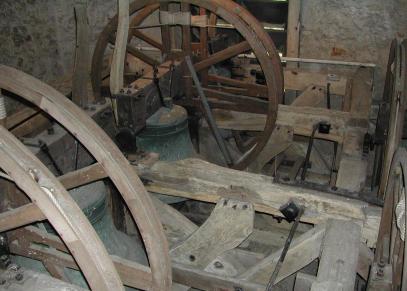A bit of history
Records do not tell precisely when bells were first installed at Brasted, but probably there was a heavy four (possibly with a tenor of around a ton) there by about 1530. The frame holding the present 4th, 3rd, 7th and tenor dates from a bit later than this (about 1580 is suggested by Chris Dalton & Chris Pickford) and, judging by the way the beams surrounding the tenor pit have been cut out, the wheels must have been enormous &some 10 feet in diameter compared with the present average of about 5 - 6 feet. It's just possible that the bells may have been hung rather lower in the tower than they are now — in fact about where the clock is now. If one examines the north face of the tower one can see that there are at least two stages of building, and it could be that the height of the tower was raised some time in the 16th or 17th centuries, and the bells raised to where they are now. In 1730 the old four were recast into a six by Richard Phelps of Whitechapel, the frame being extended to carry the two extra bells. It looks as though some of the "new" timbers added at that time were in fact secondhand, since they show signs of previous use. In 1764 the tenor was again recast, this time by Thomas Janaway of London. The details of these bells (and indeed the current bells) are available on a website called Church Bells of Kent.

A hundred and fifty years passed before any more major work was done, until 1881, in fact, when the bells were recast by Gillett Bland & Co into six (tenor 10cwt 1qr 16lb). The church was rebuilt in 1865/6, but nothing was done to the tower. It seems that bell restoration was indeed very necessary. since the Rev Charles Astley was moved to write in an open letter to parishioners in 1868,
"It needs no words of mine to impress upon you how greatly and sadly [the tower] requires restoration. It speaks for itself. Moreover the Six Bells, four only of which are at all available, ought to be re-cast and re-hung, and a new Ringing Loft ought to be constructed. Furthermore, a good Church Clock would be a great boon to the parish at large. For thoroughly restoring the Tower, re-casting and re-hanging the Bells, constructing a Ringing Loft, and providing a Church Clock, I suppose about £450 wouold be necessary. Of this sum I will most gladly give £50 . . . "
(We don't at present know what the eventual cost was, although the clock wasn't installed until 1913. This was a gift in memory of a local builder, so it may have been that the Rev Astley's estimate of costs was a bit optimistic and it was decided to skip the clock in 1881.)
In 1932 the bells were again taken out and sent to Mears & Stainbank at Whitechapel for retuning, removal of the old clapper staples, installation of new clappers and rehanging on ball bearings (click here to read the article on the dedication in The Ringing World). In 1957 and again in 1989 the clappers were rebushed. As part of the 1989 work all the wheels, which were over 100 years old, and starting to fall apart at the slightest provocation, were replaced. Whitechapel Bell Foundry did the rebushing and made the new wheels, but all local site work was carried out by the ringers themselves.
In November 1989 fire destroyed all but the walls of the choir and nave, but we were very fortunate that the flames did not reach the tower, and the bells were unharmed.
By 2003 the bells were getting rather difficult to handle, which did not make for teaching learners, especially youngsters. In January of that year the decision was made to rehang the six with modern fittings, albeit in the old frame. Removal of this frame was not possible owing to its age, and there was no real way of putting a new steel frame in the tower. As the plans gathered momentum it was suggested by someone that we really ought to complete the octave and go for a ring of eight. It was decided that we would keep the existing Gillett & Bland bells (possibly a unique six) and add two trebles. Whitechapel, who did the job, reckoned that it would be possible to tune the old six again. They'd had a go in 1932, but techniques have improved dramatically since then, as you can hear. Thus it came about that on Thursday 2 June 2005, after a lot of work by a lot of people, eight bells rang out over Brasted for the first time. For more details of the rehanging and augmentation project click on the appropriate link on the left hand panel.